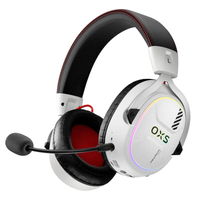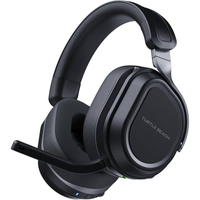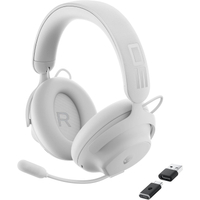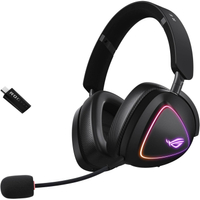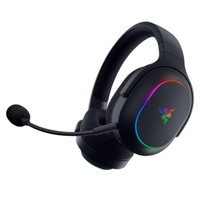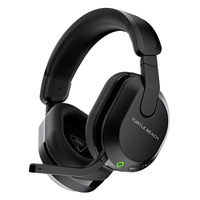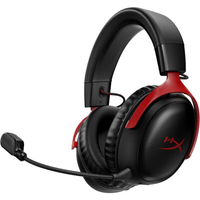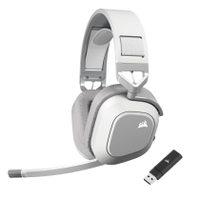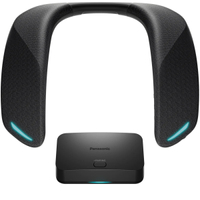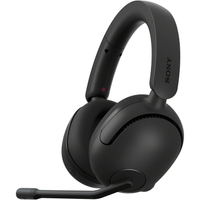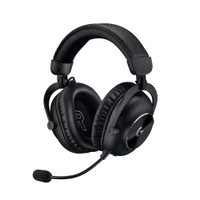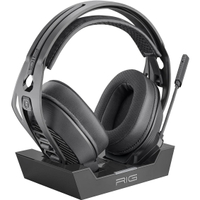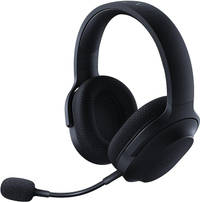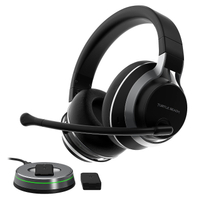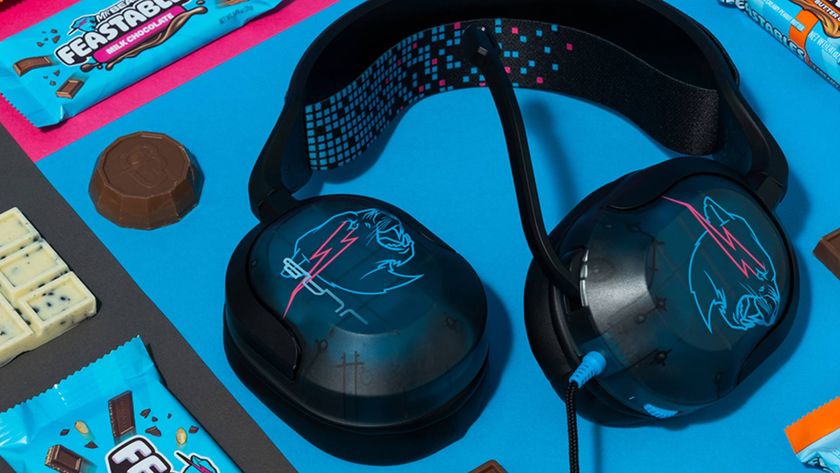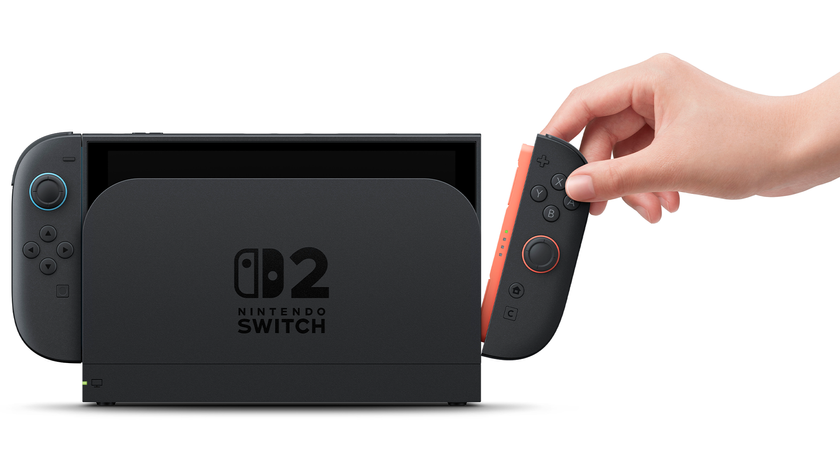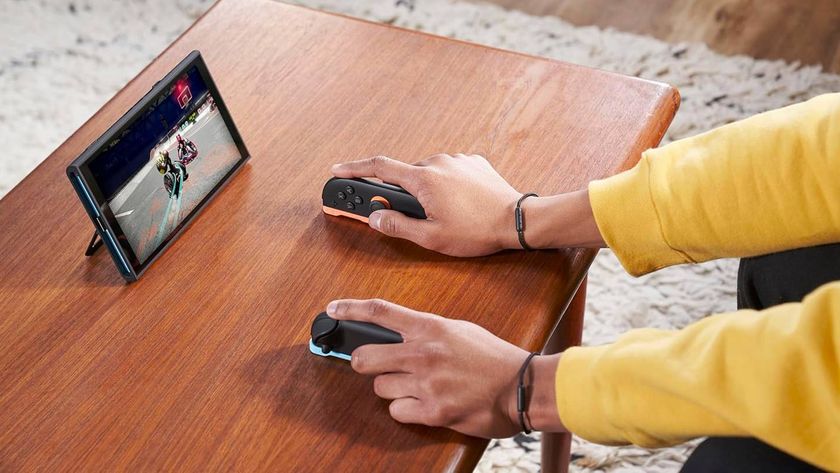The best wireless gaming headsets 2025
Go tether-free with the best wireless gaming headsets on your platform of choice - our picks from across the price ranges
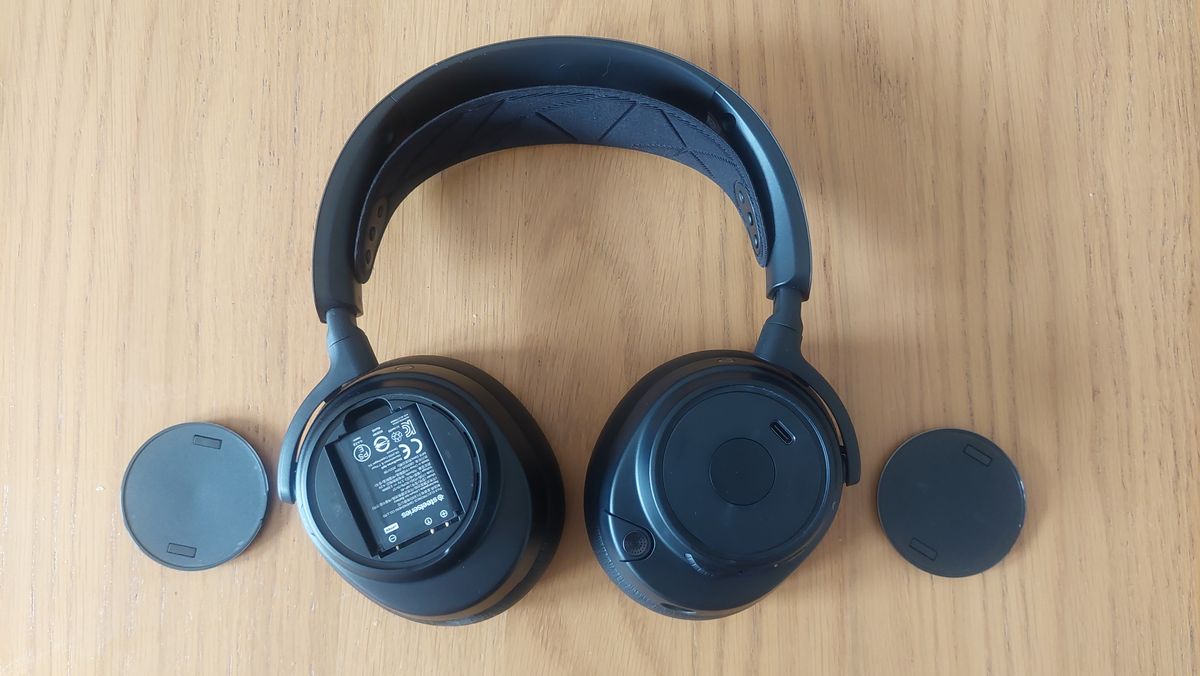
Being at the mercy of wires can be a pain. Not only can they prevent you from sitting back and getting truly comfortable when playing your favorite games, but they can entirely disrupt your next gaming session - especially if you’re prone to wiggling around in your favorite gaming chair. Luckily, there's a ton of high-end wireless gaming headsets out there, able to make your games sound their best without the need for any annoying cables.
I'm constantly testing the latest and greatest headsets, and to this day, the best wireless headset is the SteelSeries Arctis Nova Pro Wireless. Pairing top-of-the-range audio with hot-swappable batteries, a multi-connection hub, and a comfortable form factor these cups tick all the right boxes. It's the best gaming headset on the market, but if you don't want to invest in a high-end price tag there are plenty of other options as well.
Whether it's a budget friendly pair of cups, or a luxury wireless headset with all the bells and whistles, I live with these headsets, and put every single one through its paces over a range of genres and platforms to make sure it's up to standard. That means you can feel reassured you're getting the best value for money no matter the budget. Not only do the best wireless headsets need to offer excellent wireless performance, compatibility, and battery life but they also need to sound great, feel comfortable, and look the part as well.
The Quick List
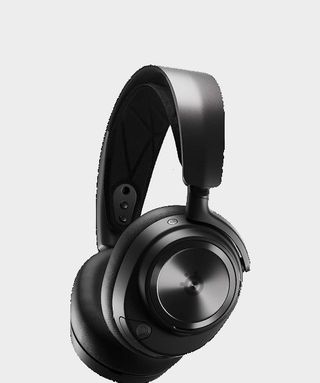
The SteelSeries Arctis Nova Pro Wireless is our favorite gaming headset on the market, but its unique features also make it the best wireless option.
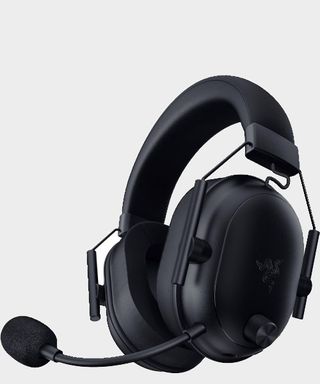
With its comfortable price tag, excellent audio, and even better microphone, the Razer BlackShark V2 HyperSpeed is the best option for most players.
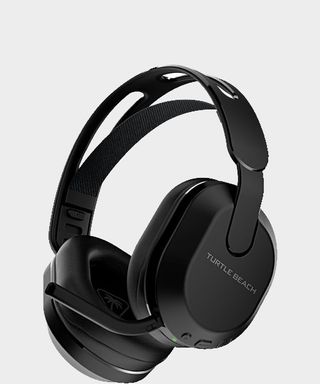
Turtle Beach's cheapest wireless headset is the best for those after 2.4GHz and Bluetooth connections for under $80 / £80 right now - plus it improves battery life over older models.
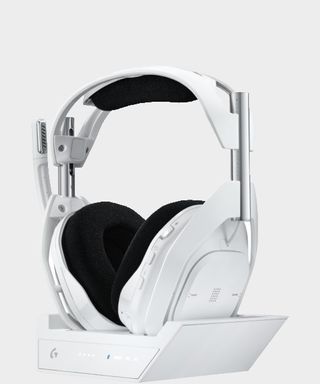
With its baked in HDMI switcher and flawless compatibility with both PS5 and Xbox Series X, the Astro A50 X is the best multiplatform wireless gaming headset. Its Bluetooth stumbles are frustrating but it's perfect for a full setup.
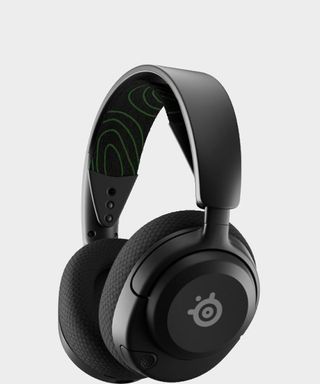
The Arctis Nova 5x has the same drivers as the 7x but also features a range of console-specific EQ features that are perfect for consoles.
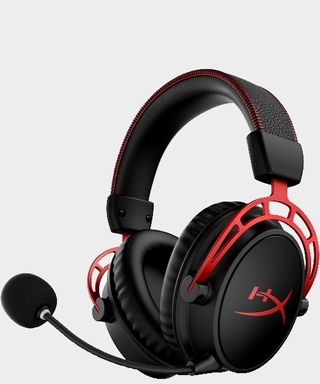
There's a massive 300 hour battery hidden in these still comfortable earcups. That's astounding considering you're still getting excellent audio quality and a lightweight build.

Gaming headsets have been glued to my head even longer than I've been reviewing them during my time as a gaming tech writer, and that includes ones not tethered by wires. Great audio quality, a high-end mic, customization options, and comfort are equally as important where wireless gaming headsets are concerned, but more so is ensuring you have a latency-free connection and an adequate battery life. These extra factors can come at a cost, but luckily there's a plethora of different wireless headsets out there for every budget, and I'm here to advise you on picking the right pair for your gaming needs.
Recent updates
March 3 - For this update, I included both the Turtle Beach Stealth 700 Gen 2 and the OXS Storm G2 wireless gaming headset to the 'also tested' section at the bottom of this guide. The Stealth 700 Gen 3 impressed me with not just it's sound, but due to the fact it came with an additional 2.4GHz dongle for PS5 and PC connectivity, despite it being designed primarily for Xbox consoles. However, it's pricier than other mid-range headsets already present on this list. Additionally, the OXS Storm G2 wireless headset offered up Bluetooth and 2.4GHz, however neither were compatible with Xbox devices, and Bluetooth wasn't compatible with the PS4/PS5, making it more limited than other sub $100 wireless gaming headsets on the market. However, I'm currently testing the Corsair Virtuoso Max wireless gaming headset which could alternatively earn a spot on this list.
The best wireless gaming headset overall





1. SteelSeries Arctis Nova Pro Wireless
Our expert review:
Specifications
Reasons to buy
Reasons to avoid
The SteelSeries Arctis Nova Pro Wireless is a go-to for anyone looking to invest in a high end audio system packed with additional extras. It's not just the best wireless gaming headset I've tested, but it's the best set of cups I've ever had on the test bench.
✅ You want to invest: This is a sizeable chunk of change, but if you're investing in a long term solution for a multiplatform setup it's a well placed bet.
✅ You have a split PC and console setup: The dual connection hub (and audio quality across a range of devices) means those who play across a couple of platforms are going to get the most out of this investment.
✅ You don't want to worry about battery: The genius dual-battery solution means you won't have to worry about juicing up before you play - with one charge on the dock you've always got a spare 22 hours.
❌ You don't play across multiple platforms: If you're not going to use that DAC hub as intended, there's no point in spending more on it.
❌ You don't want to tinker with EQ settings: We did need to fiddle with the EQ settings straight out the box, so if you're after pristine sound right away a more streamlined device will come in handy.
Design: The latest SteelSeries Arctis Nova line retains a core aesthetic throughout its models, but everything is dialled up to 11 in the Pro. The luxury build materials, super comfortable ski-google headband and subtle gray color means the Nova Pro Wireless could easily pass as a luxury set of headphones, without even considering the raw gaming power inside. I can easily blitz through hours of gameplay with these on my head, without even feeling an ear pinch. There's plenty of extra features hidden in that slick design, though - which makes its streamlined effect all the more impressive.
Features: The SteelSeries Arctis Nova Pro Wireless astounds with its feature list. First up we've got one of the most helpful battery solutions I've come across so far, hot-swappable battery packs. One slots neatly into the hub (more on that next), while the other sits inside the headset - that means you'll never run out of charge, simply swap them over when you're running low. I'm constantly forgetting to plug in, so always having a full charge ready to go has been a game changer over the years. That main hub is another beast all together. Offering handy multiplatform connections and a direct platform for EQ tweaks. Throw in active noise cancellation and plenty of controls on the headset itself and you've got a serious powerhouse.
Audio: The Nova Pro Wireless wouldn't be at the top of this list if its audio wasn't sublime. The latest iteration has taken the natural clarity of SteelSeries' drivers and boosted everything with an extra edge of finesse and detailing. Not only is this a supremely spacious soundstage, with excellent attention to detail across all ranges, but we also noticed a boost in the lower regions which has been missing from previous Arctis iterations.
Verdict: If you have the budget, then this is the easiest recommendation for a wireless gaming headset I can make. It's simply the best wireless gaming headset I've ever tested. The Arctis Nova Pro Wireless delivers on its promise and goes as far as I've witnessed any premium set in justifying the lofty price tag.
Read more: SteelSeries Arctis Nova Pro Wireless review
Comfort | 5/5 |
Audio | 5/5 |
Battery | 5/5 |
Microphone | 5/5 |
Versatility | 5/5 |
Build quality | 5/5 |
The best wireless gaming headset for most players




2. Razer BlackShark V2 Hyperspeed
Our expert review:
Specifications
Reasons to buy
Reasons to avoid
If you're after a wireless headset that punches above its price tag but is still easily plug-and-playable with a range of platforms, the Razer BlackShark V2 Hyperspeed is your guy. Its wireless connection is limited to PC, PlayStation, mobile and Nintendo Switch, but a USB-A wired option is there for Xbox players should they need it, and you're getting some particularly premium parts in here for a great price.
✅ Audio quality is a priority: Razer has prioritized audio quality over extra fancy features and build materials here - so if you're doing the same it's a perfect match.
✅ You regularly play with chat: The Hyperspeed actually shares the same mic as the BlackShark V2 Pro further down this page - and that device is the best microphone we've tested so far.
✅ You play across PC and PlayStation: The wireless connection does favor PC and PlayStation consoles, so you're getting the best bang for your buck if that suits your setup. However, USB cable can still hook you up to an Xbox.
❌ You need a particularly durable design: The build materials used here aren't quite up to the same luxury standard as more expensive headsets. If your cups need to be able to take a beating we'd recommend moving further up the price range.
❌ You want to take your headset on the go: That non-detachable microphone and lower build quality means this isn't one for regular travel.
Design: At first glance, the BlackShark V2 Hyperspeed could be its much more expensive sibling, the more expensive BlackShark V2 Pro model. This is a matte black headset with the line's staple pilot-style silhouette, chunky headband, and oval shaped cups. However, closer inspection did reveal some small tears in my review unit, and some looser stitching.
That, combined with the cheaper plastic used here, is indicative of a sacrifice in build quality in order to achieve such a low price tag. You're still getting a strong design for your cash, with cool and comfortable leatherette cushioning, plenty of padding, and a suitable clamp force, but if you need a long-lasting device you might need to go further up the price scale.
Features: That lower rate build makes way for some excellent value in the features department. A 70 hour battery puts the BlackShark V2 Hyperspeed well ahead of similarly priced competitors, Bluetooth and 2.4GHz connections keep you connected to pretty much anything, and an extended volume dial on the side makes quick in-game adjustments particularly easy. Then there's that super wideband microphone - the best I've tested so far. This is a crystal clear, almost podcast-worthy mic that delighted in our testing, both across recording and in-game chat.
Audio: The BlackShark V2 Hyperspeed packs the microphone of the far more expensive Pro model, but it also offers the same TriForce Titanium drivers. This is a luxury piece of kit, offering incredible clarity and richness to pretty much anything you can throw at it. Everything is well-balanced across each range, with particular attention being paid to mids and lows. That's an area that can often become muddled with cheaper wireless headsets, but there's excellent detailing down here with space for more atmospheric environmental sounds and loud, accurate directional cues as well.
Verdict: It's difficult to match the Razer BlackShark V2 Hyperspeed's internal quality at this price point. While the headset does sit back a little when it comes to overall build, those willing to take care of their cups will be delighted with this little bargain - especially if you spend a lot of time in more competitive settings.
Read more: Razer BlackShark V2 Hyperspeed review
Comfort | 4/5 |
Audio | 5/5 |
Battery | 4/4 |
Microphone | 5/5 |
Versatility | 4/5 |
Build quality | 3/5 |
The best budget wireless gaming headset




3. Turtle Beach Stealth 500
Our expert review:
Specifications
Reasons to buy
Reasons to avoid
If you've got a hard $80 / £80 budget but you still want a wireless gaming headset, the Turtle Beach Stealth 500 is the best value on the market right now. It's a little weedier than other options closer to $100, but considering the price point it's still a fantastic contender.
✅ You can't go near $100 / £100 - The Turtle Beach Stealth 600 is a better headset overall, and only comes in at $20 more. At this point, that's more of a mid-range budget than entry level, though.
✅ You prioritize comfort - The Stealth 500 actually offers a more comfortable experience than the more expensive 600 Gen 3 model, with a floating headband design that alleviates pressure.
✅ You regularly play on handhelds - The Bluetooth connection is adding a little to the price compared to older releases, but is a fantastic addition for those who regularly play on a handheld PC or Nintendo Switch.
❌ The Stealth 600 is on sale - The jump between the Stealth 500 and 600 Gen 3 is a big one, and there's only $20 difference between the two. If the bigger model is on sale, I'd recommend opting away from this budget option.
❌ You travel regularly with your headset - If your headset needs to be able to withstand a more hectic journey, I'd recommend leaving the Stealth 500 at home. There were enough durability concerns in my testing to suggest that this one might not fare well with rough and tumble.
Design: The Turtle Beach Stealth 500 actually beats the slightly more expensive Stealth 600 Gen 3 Wireless in the comfort arena. With a floating headband design not too dissimilar to those seen in SteelSeries headsets, the 500 sits beautifully on the crown, without any unnecessary pressure. While the actual cushioning of each cup is a little less plump than the 600s, the lack of that harder headband more than makes up for it.
It's worth noting that this isn't going to be a a headset that fares particularly well when thrown in a backpack. The build quality of my test unit was a little concerning, with fabric stretched too tight over the cushioning of one cup, resulting in creases and strained stitching. The cheaper plastic frame does let you know this is a budget device, but it also keeps the weight down as well.
Features: I previously held the now four-year-old SteelSeries Arctis 1 Wireless as the best budget option, but it's been aged out by the Stealth 500. Where SteelSeries' previous generation cups offered 20 hours of battery life for $99 MSRP, the Stealth 500 packs up to 40 hours for $20 less. While the Arctis 1 relied on a 2.4GHz connection only, the Stealth 500 adds Bluetooth into the mix as well as a quick switcher button to instantly swap devices. This is one of the first budget wireless headsets I've tested that includes these traditionally more premium features - and they mean mobile and handheld use are now far easier in the entry level category.
There's an abundance of controls on the headset itself, though they did feel a little clustered when I first started using it. Plus, Swarm software is there to provide EQ and microphone adjustments as well as a full mobile app as well.
Audio: There's a bouncy quality to the Turtle Beach Stealth 500's sound quality that I wouldn't have expected to hear from a headset this cheap just a few years ago. There's also no hint of over-pumping the bass, which historically results in distorted audio among the lower price ranges as well. There's a good amount of power in these basslines, which can sometimes cluster up the mid-section, but overall audio quality is crisp, clear, and detailed for the price.
Verdict: The Turtle Beach Stealth 500 is the cheapest wireless headset I've tested that has actually impressed me in a while. For just a little extra cash, the Stealth 600 does improve on sound and build quality, but if you've got a harder budget it's likely these cups will be far cheaper on sale.
Read more: Turtle Beach Stealth 500 review
Comfort | 4/5 |
Audio | 3/5 |
Battery | 2/5 |
Microphone | 3/5 |
Versatility | 4/5 |
Build quality | 2/5 |
The best wireless multiplatform headset




4. Astro A50 X
Our expert review:
Specifications
Reasons to buy
Reasons to avoid
While the fact that its Bluetooth is limited to the base station itself, the Astro A50 X boasts an incredible unique feature that makes it the best wireless gaming headset for anyone splitting their time between PS5 and Xbox Series X. That's the built in HDMI swapper, allowing for full compatibility between systems and easy switching between that at just one press of a button.
✅ You play PS5 and Xbox Series X in one setup: If you're running a PlayStation and Xbox next to each other you're going to get the best value for money possible here.
✅ You don't want to play handheld on the go: Switch players and handheld gamers on the go will need Bluetooth baked into the headset itself rather than just the base station.
✅ You regularly switch between consoles: If you're hopping between inputs regularly, that easy switch button is going to prove its worth particularly quickly.
❌ You want to play on the go with handhelds: If you don't want wireless audio to be bound to your home, you'll need to look elsewhere.
❌ You need ANC: The Astro A50 X doesn't pack active noise cancellation features, though many in this upper price range do.
Design: The Astro A50 X doesn't stray too far from its predecessors in its design. The plastic device keeps the clean angular lines and large cylindrical headband struts of older releases, with a particularly sophisticated final effect. It's available in either black or white, but I do prefer the white model I tested - the geometric style of the base station and the softer curves around the bottom of each cup pick up particularly well in this colorway.
Construction feels solid in the hand, with plenty of rotation to ensure an optimal fit from each cup. I did note that the swivel on each side made placing the headset into the charging dock was particularly fiddly - especially considering the contacts need a little wiggling around to truly connect. Everything is nicely comfortable, with plush padding across the middle of the headband and lining each cup.
Features: This is the big one. The reason so many wireless gaming headsets are either designed for Xbox or PS5 is because the two consoles just don't speak the same connection language. However, Astro has skirted this issue by taking its audio from the HDMI signal instead. Around the back you'll find space for both consoles to connect via HDMI 2.1 (as well as a USB-C for your chat). Once set up, and provided your consoles are set to rest rather than being turned off, the base station can swap both video and audio between them at the press of a button - all while keeping the full 4K 120Hz signal intact.
There's a but here, one I found when trying to use the Astro A50 X for Nintendo Switch. The Bluetooth connection is tied to the base station itself, which means you won't be able to use the A50 X on the road with a handheld device. Similarly, those who use a PC in a different setup to their consoles will also be stuck transporting the entire base between setups. That quickly became frustrating during my testing, and would be enough reason for me to only recommend this headset to those with an all-in-one setup.
This is the best audio I've personally heard through a gaming headset yet
Astro A50 X review
Performance: That slick design and fancy feature set wouldn't be good for anything if these headphones didn't sound as great as they do. This is a particularly powerful sound profile, with a slight emphasis on the lower mid-range, but still nicely defined higher tones with plenty of space in the soundstage. That makes everything from music to games feel just that little bit more vibrant, especially considering the Astro A50 Xs do such a good job at separating more delicate sound effects from even the most chaotic of background gunfights.
Verdict: The Astro A50 X is heavily reliant on its base station, even needing it for Bluetooth functionality, however if you've got a setup that suits it (your PS5, Xbox Series X, and possibly PC all sharing one screen) it's going to be a game changer.
Read more: Astro A50 X review
Comfort | 4/5 |
Audio | 5/5 |
Battery | 5/5 |
Microphone | 3/5 |
Versatility | 3/5 |
Build quality | 4/5 |
The best wireless gaming headset for consoles




5. SteelSeries Arctis Nova 5X Wireless
Our expert review:
Specifications
Reasons to buy
Reasons to avoid
We previously had the SteelSeries Arctis Nova 7X in this position, but then the newer Nova 5 Wireless dropped. This slimmer headset packs the same audio quality as the more expensive option, but drops simultaneous connectivity in favor of a set of console-specific EQ presets that are more than worth it.
✅ You want tailored audio: It's difficult to find a wireless headset that will provide the same kind of game-tailored audio on console as it will on PC. The presets available in the Nova 5's companion app are incredible considering this is such an untapped market.
✅ Your headsets take a beating: This is a particularly durable build, with nicely flexible materials and solid construction. If your tech needs to withstand some knocking around, this is a fantastic option.
✅ Comfort is a priority: Not only is this a slimmer, lighter headset, but its design means there's no ear-clipping and the entire frame can hold up comfortably for longer sessions.
❌ You direct EQ sliders: While there is a massive selection of presets available, finer controls over each EQ slider is still reserved for PC use.
❌ You rely on comms: The microphone in here isn't as good as other options (see the Razer BlackShark range), so if you're going to playing competitively for most of the time you might want to look elsewhere.
Design: SteelSeries didn't rip up its rulebook with the latest release. This is still the same ski-band style headset you'll recognize from the rest of the range. That means you're getting smaller, more circular cups than you find on other models, but still fantastic comfort that lasts. I noted that the seal created by these particular cups was particularly strong in my testing as well, so while there's no ANC on board the form factor manages to create a solid isolation.
This thing is solid as well. No matter how much I bent and shaped the headband, or shook the cups, there was no creaking, splintering, or rattling anywhere. That's a big vote of confidence for long-term durability.
Features: The biggest reason I'm putting the Nova 5X Wireless up as the best wireless headset for consoles is the companion app. There are over 100 presets in here, covering a massive range of games, covering everything from Fallout to Fall Guys. A Bluetooth connection keeps you in-tune with your phone while a 2.4GHz receiver runs up to your Xbox, but it's worth noting there's no simultaneous connections here. Higher-end headsets will allow you to, for example, listen to music on your phone while still running game audio from another source. However, you're switching between inputs here.
Still, you're getting a good spread of onboard controls to go with those presets. A chat mix dial and Bluetooth quick switcher are both added here (the Nova 4 drops these features), alongside the everyday volume, mic mute, and power options. A solid microphone is tucked away in the cup itself, extendable whenever it's needed.
Performance: Considering you're still getting the excellent audio quality we heard in the Nova 7s, the 5X Wireless offers fantastic value for money overall. This soundstage is particularly strong in its detailing with plenty of attention paid to the lower ranges. That does mean there's less of a booming bass here, but with the mid-range remaining crystal clear everything is tuned to games here. And that's even more apparent when fiddling between different presets. While some feel a little redundant (Fall Guys doesn't particularly benefit from souped up audio), these settings are thoughtful in their approach meaning even Baldur's Gate 3 and Mario Kart 8 feel their benefit.
Verdict: The SteelSeries Arctis Nova 5 Wireless does make some sacrifices when put up against high-end headsets (simultaneous connections being the most notable). For the cash, though, there's no better value out there for console purists.
Read more: SteelSeries Arctis Nova 5 Wireless review
Comfort | 5/5 |
Audio | 4/5 |
Battery | 3/5 |
Microphone | 5/5 |
Versatility | 4/5 |
Build quality | 5/5 |
The best wireless gaming headset for battery life






6. HyperX Cloud Alpha Wireless
Our expert review:
Specifications
Reasons to buy
Reasons to avoid
The HyperX Cloud Alpha Wireless is an extraordinary headset and does earn a place on this best wireless gaming headset list - but it is also a frustrating set; stumbling with one feature that could have really made it a world-beater.
✅ Battery is everything: That 300 hour battery life isn't something you see every day. If you're just after fantastic audio you don't need to think about charging, this is the headset for you.
✅ You mostly play single player: That mic is particularly weak, which means we can only recommend this wireless headset to those on solo adventures.
❌ You play online with chat: This is perhaps the strongest 'don't buy it if' recommendation on this page. The HyperX Cloud Alpha Wireless does have a particularly disappointing mic - if you play online with chat, we'd seriously urge you to look elsewhere.
❌ Charging isn't a hassle: Of course, that battery life costs money. If you don't mind plugging in every now and then you may find other options more appealing.
Design: The design and build are classic, quality HyperX: a simple black and red design with sturdy arching frames for each cup, and a solid and comfortable headband between the two. And the buttons are simple and restrained too - just a volume wheel on one cup, and the mic port, mic mute, power button, and charging port on the other.
Features: The battery life is the main feature here though, and the thing that all the marketing around this headset banged on about - claiming up to 300 hours of battery life, no less. And, I have to say that I have come to believe that claim wholeheartedly: after 110 hours I have had to give up counting just to move on with my life, while the chap in the earcups tells me it has gone down to only 70%. It really is remarkable and a big selling point for the set.
However, the big caveat with this headset is that I found the mic to be really quite bad. Covering all of what you don't want from a microphone - muffled audio to my friends, crackling, inconsistent volume, and indistinct clarity - at times I was having to basically put it in my mouth to be heard.
Audio: The sound quality is truly excellent. No matter what game we were playing during testing, the Cloud Alpha Wireless's audio shone and excelled. It will have your back whatever you play from the busiest of chaotic shooters to the quietest meanders through open-world landscapes, and everything in between. We were particularly impressed with the clarity of each and every detail of the audio too, from booming weapons to the tweeting of birds. The headset is even excellent for music and TV and film too which is a great plus.
Verdict: What results is a headset that is seriously perfect for you if you don't play much, if any, online games that require communication - if you do, then there might be a better set on this list for you.
Read more: HyperX Cloud Alpha Wireless review
Comfort | 4/5 |
Audio | 4/5 |
Battery | 5/5 |
Microphone | 1/5 |
Versatility | 3/5 |
Build quality | 4/5 |
How we test wireless gaming headsets
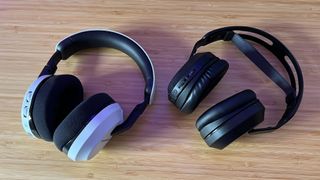
We use each wireless gaming headset that passes our desks as if we had just purchased them ourselves. That means running through all daily work, play, streaming, and music using the device while also scrutinizing build quality, comfort, and ease of use throughout.
The first thing we note when removing a headset from its box is, inevitably, design. There's more than just a subjective appreciation for aesthetic in this process, though. A headset's weight, balancing, cushioning depth and materials, and microphone placement will all contribute to the overall comfort of a device. We test this comfort long-term by running several longer gaming sessions through each wireless headset, and by spending work days plugged into music and meetings for extended periods of time. Beyond ergonomics, though, a wireless headset needs to hold up in its build quality.
We flex, bend, swivel, and bop every hinge and headband on a wireless headset, constantly listening and feeling for creaks or wobbles to ensure a build is robust. Beyond noting the actual materials and connections used, we're putting every strut and cushion through its paces through fiery rage quits and more professional drop tests.
While wireless headsets generally offer similar spec sheets when it comes to features, there are always going to be individual aspects that stand differently. We fully test each wireless headset across all its connection types; Bluetooth, 2.4GHz, and wired. That means testing across a range of platforms in each connection mode as well - paying particular attention to range, strength, reliability, and speed.
Beyond that all-important connection, we're constantly evaluating how onboard controls enhance or hamper everyday and competitive experiences while also putting the mic through stringent team tests and work calls. Battery life is one of the first features we explore, though. As soon as a wireless headset comes out of the box, we charge it fully and allow that full charge to run its course naturally over the course of at least two weeks full work and play. That can be anything from eight to 13 hours of use per day.
In order to examine audio performance, we test across a range of different genres, from the vast spaces of an open world to more close-quarters combat scenarios. Of course, sound is always subjective, so we test across the same seven games every time. These titles are spread across different platforms and offer their own specific challenges across directional accuracy, soundstage size and precision, frequency power and clarity, and potential for distortion.
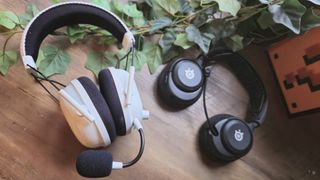
Marvel Rivals and CS2 are our competitive games of choice, used for testing directional accuracy, microphone clarity, and soundstage imaging, particularly in the lower mid-range. We use a wider open scene with a couple of nearby machines in Horizon Forbidden West to see how well each headset deals with a cluttered mid-range, and how well it balances these more clustered scenes. Marvel's Spider-Man Miles Morales is used to measure directional audio in a busier scene (the main mission Time To Rally).
Doom Eternal tests a gaming headset's power in the lower range, as well as the depth of its soundstage. Dead by Daylight is used to measure a less busy, but more atmospheric, environmental soundstage and how it places voice-chat within the audio soundscape. We finally use each headset across a few levels of Super Mario Sunshine or Super Mario Galaxy to assess the handling of higher ranges as well.
Some game choices can differ depending on any given reviewer's access, and it's always pertinent to test headsets during a whole range of games, including titles even outside our specified list. Ensuring we're using not just the same games across each headset we test, but also brand-new releases is pertinent to recommending each and every set of cups.
Once each headset then makes it through the full testing process, it is assigned scores based on comfort, audio, battery, microphone, versatility, and build quality for each comparison across previous reviews. We're constantly comparing headsets to their similarly priced competitors - often switching back and forth between the devices during testing.
For more information on how we test gaming headsets, check out the full 12DOVE Hardware Policy.
Also tested
We're testing new wireless gaming headsets all the time, and not all of them make it into this list. The headsets below could still fill that hole in your setup if they suit your specific needs, but their feature sets might not be as widely applicable as the models up top, or they might have fallen below expectations in other areas of testing. Below, you'll find all the wireless headsets we've tested in the last two years that haven't met the correct criteria to be featured in our best list.
OXS Storm G2 wireless headset | Available at Amazon
This sub $100 budget wireless gaming headset from OXS comes decked out in a unique, off-white design and provides Bluetooth and 2.4GHz options when it comes to wireless connectivity. However, from the get-go, not only is is not compatible with Xbox consoles, but its Bluetooth functionality doesn't work with the PS4/PS5, making this a pretty limited budget gaming headset. While it provides a comfortable fit, and has a great microphone, other sub $100 wireless headsets, alternatives like the Turtle Beach Stealth 500 aren't as limited with their connectivity, making the Storm G2 miss a pot on the best wireless headset list.
OXS Storm G2 wireless headset review
Turtle Beach Stealth 700 Gen 3 | Available at Amazon
The Stealth 700 Gen 3 is the latest addition to the Stealth headset line, introducing high-end 60mm dual eclipse audio drivers to a mid-range pair of cups with a $199.99 / £179.99 price point. As a wireless headset it provides Bluetooth and 2.4GHz options, and despite being designed with the Xbox in mind, it comes with an additional 2.4GHz dongle for PS5 and PC, which is a welcome addition. Despite it's impressive connectivity support, it's a bit pricier than other mid-range wireless headsets already part of this list and so, for now, misses a spot as one of the best wireless gaming headsets.
Alienware Pro Wireless headset | Available at Amazon
The Alienware Pro wireless gaming headset is a sleek entry for the Alienware brand which sits on the mid-range of the market with its $229.99 / £221.99 price point. It's a more affordable alternative than its wireless headset rivals, such as the SteelSeries Arctis Nova Pro Wireless headset. However, even with its luxurious features such as the inclusion of Dolby Atmos audio, and active noise canceling, the Arctis Nova Pro still takes the top spot as our best wireless headset due to its flexible mic integration, hot-swappable batteries, and high-end audio quality that the Alienware Pro Wireless pair of cups doesn't quite live up to.
Alienware Pro wireless headset review
Asus ROG Delta II | Available at Amazon
The Asus ROG Delta II headset piles up new features on top of the existing Delta line, including adding simultaneous connectivity to consoles via Bluetooth and 2.4 GHz into the mix. However, at a price range of $229 / £219 it doesn't quite live up to the expectations set by more affordable alternatives like Razer's BlackShark V2 Hyperspeed or the SteelSeries Arctis Nova 5X.
Razer Barracuda X Chroma | Available at Amazon
The Razer Barracuda X Chroma (2024) introduces RGB lighting to the Barracuda lineup for the first time and still manages to uphold the sound and build quality that the previous headsets established. The multi-platform excellence providing an easy switch between Bluetooth and 2.4GHz wireless connections on the PS5 is still on full display, but this flashy add-on comes at a cost of $129.99/£129.99 making the previous model a more budget-friendly wireless alternative.
Turtle Beach Atlas Air | Available at Amazon
The Turtle Beach Atlas Air is a revelation in the world of open back gaming headsets. Packed with features and endlessly comfortable it's one of the biggest releases of the year. Two-way sound bleed isn't for everyone, though.
Turtle Beach Atlas Air review
5/5
Reviewed June 2024
Turtle Beach Stealth 600 Gen 3 | Available at Amazon
The latest Stealth 600 headset is a fantastic device in its own right, offering excellent battery and audio for under $100. However, it's got cheaper options like the Corsair HS65 beating it for sheer price and slightly more expensive models like the Nova 5x winning for overall value across the market.
Turtle Beach Stealth 600 Gen 3 review
3.5/5
Reviewed June 2024
HyperX Cloud 3 Wireless | Available at Amazon
The HyperX Cloud 3 Wireless is a solid cord-free headset, but it's just a little too limited by its lack of Bluetooth to truly be considered among the best - especially considering its price. You'll still find a particularly comfortable headset here if you are happy solo-ing a 2.4GHz receiver, with a battery life second only to the Cloud Alpha Wireless above.
HyperX Cloud 3 Wireless review
3/5
Reviewed June 2024
Corsair HS80 Max | Available at Amazon
At full price, the Corsair HS80 Max doesn't offer enough to separate it from the much cheaper Razer BlackShark V2 Hyperspeed. These are similar headsets in their objectives, they offer high-quality wireless audio for PC and PlayStation in a simple plug and play form factor. While the HS80 Max is built better than Razer's option (and has a longer battery life), its microphone, lack of Bluetooth, and audio quality can't compete.
Reviewed April 2024
Panasonic Soundslayer Wireless | Available at Amazon
The Soundslayer Wireless is a neat piece of tech, with wearable speakers slotted into each side of a wearable device. That means no ear-fatigue and pretty solid surround sound effect. However, with no Bluetooth, noticeable distortion at high volumes, and less powerful audio compared to similarly priced headsets we wouldn't recommend it to most players.
Panasonic Soundslayer Wireless review
3/5
Reviewed February 2024
Sony Inzone H5 | Available at Amazon
We got our hands on the Sony Inzone H5 in November last year but it didn't quite make this top list. It's designed as a PS5 and PC headset, but its feature set doesn't really lean into either use-case. There's better out there for the money, but if comfort is your priority it's well worth a look.
Reviewed November 2023
Logitech G Pro X 2 | Available at Amazon
The USB-A 2.4GHz receiver was a little weird to find on this 2023 release, but it was the low quality mic that kept it off this list. Still, if you're after graphene drivers and a tried and tested form factor, it's a worthy investment for single players.
Reviewed July 2023
RIG 800 Pro HS | Available at Amazon
Like the look of the Astro A50 X's charging dock? The RIG 800 Pro HS comes with a similarly designed charger and a much lower price tag. However, the build quality kept it from a place on the top list, as did its older connection options.
Reviewed May 2023
Razer Barracuda X | Available at Amazon
The Barracuda X was one of our top wireless headsets for a long time, but its price tag hasn't caught up with its age. It's still a fantastic buy, especially for Nintendo Switch, but there's better value on the shelves now.
Razer Barracuda X (2022) review
4/5
Reviewed April 2023
Turtle Beach Stealth Pro | Available at Amazon
Before the A50 X came along, the Turtle Beach Stealth Pro was our favorite multiplatform wireless headset. These days you'll find it sitting just a little too expensive compared to other headsets that come in at a similar price but offer far better quality overall.
Turtle Beach Stealth Pro review
5/5
Reviewed April 2023
How to choose the right wireless gaming headset
Why you can trust 12DOVE
Finding the right wireless gaming headset for you comes down to a series of factors; what, how, where, and when you play. Each of these factors has a different bearing on the connection, overall design, microphone, and battery life of your device. Of course we all want the best audio experience possible - but finding the right combination of these extra features can help you get the best value for money overall.
That's because some players might be able to stick with more expensive features like a 2.4 GHz wireless connection or high-end microphones in order to pick up far better sound quality for their money overall. On the other hand, some may prefer to put more cash towards a long-lasting battery life and versatile suite of connections rather than prioritizing competition-level sound, so a wireless headset just won't do. Finding the right balance of priorities can help you find the right headset at the right price.
Form factor
Form factor might make more of an impact on the versatility of a headset than its connection at this point in time. Wireless gaming headsets still look like they're built for games - which isn't ideal when you want your premium purchase to double up outside of the house. If you want to use your headset on your commute, I'd recommend picking up a smaller 40mm set of cups with full 180 degrees of rotation in the hinge and a softer, less angular design.
Form factor also balances the weight of your headset. If you know you're going to be playing for long periods of time, it's well worth prioritizing a lightweight device. While you might drop a little battery life, the benefits to your skull are immeasurable. 240g - 280g is considered nicely lightweight.
Microphone
This might be an easy no-brainer, but it's worth investigating the microphone options available to you. If you only play with chat on, you'll want to invest a little more in your microphone quality than someone who only plays solo. On the flip side of that, it's well worth making sure that your microphone is detachable if you do play single player - there's nothing more annoying than an extra boom in your face that you never need.
A lot of wireless headsets now ship with flip-to-mute mics or arms hidden inside the cups themselves. While they're often a little more expensive, this is the best option for those who swap between playstyles as you'll never have to worry about losing that extra accessory. Luckily, some of the more expensive wireless headsets will likely already have a end end mic in tow.
Battery life
There are headsets out there that max out battery life but drastically sacrifice other features to get there (looking at you HyperX). In general, most headsets aim for around 50 - 100 hours of battery. If you play for a couple of hours every evening, that will see you sorted for a good few weeks.
I would recommend moving to the top of this range if you regularly play on a handheld on the go, or in a travelling setup. There's nothing worse than forgetting to plug in the night before and being met with a beeping headset first thing in the morning. However, if you only ever tend to play at home, you can afford to shrink your battery in favor of other features like audio quality or a lower weight - especially if the headset offers a wired connection as well.
If the wireless gaming headset of your choice has active noise canceling (ANC) features, toggling these on will drain the battery as a pretty fast rate. If ANC features are a priority, it's worth signalling out headsets with battery solutions like spare rechargable batteries, or ones integreating with fast charging so there's always enough juice to keep you going.
Glossary
Whether you're buying your first wireless headset or you're simply looking to brush up on some key terms before diving into your research, you'll find all the jargon laid out just below.
- 2.4GHz: A low-latency wireless connection alternative to Bluetooth.
- ANC: Active noise cancellation removes unwanted external noise by sensing it with an external microphone and blocking it with an extra sound frequency.
- Bluetooth: A slower but more widely compatible wireless connection option compared to 2.4GHz.
- Closed-back: The most common headset design, where the driver is completely enclosed within the cup itself.
- Driver: The element of a gaming headset that converts electrical signals into sound waves.
- Dual-connection: A feature of wireless gaming headsets that means it can connect to both 2.4GHz and Bluetooth.
- Dynamic: The most common driver type featured in gaming headsets.
- EQ: Short for equalizer, EQ settings allow you to fine-tune your listening experience by manipulating the emphasis on certain ranges, usually via a separate software.
- Frequency range: The range of sound that a headset can produce, usually 20Hz - 20KHz
- Latency: The speed at which the headset receives information from the PC or console, a higher latency should be avoided if playing competitively.
- Open-back: A less common headset design in which the driver is left exposed through the chassis.
- Receiver / Transmitter: An attachment or hub that receives mic signal from your headset and transmits audio signal to your headset. Usually a small USB-C or USB-A dongle, or a larger box.
- Simultaneous connection: A wireless headset feature that allows for separate Bluetooth and 2.4GHz connections to be active at the same time.
Best wireless gaming headset: FAQ
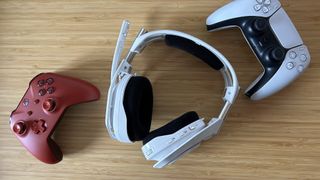
What is the best wireless gaming headset?
The best wireless gaming headset right now is the SteelSeries Arctis Nova Pro Wireless. We always strive to fill our guides with headsets that will appeal to everyone, no matter your preferred platform, audio grade, or budget. That means those striving for value for money should grab the Turtle Beach Stealth 600 Gen 2 and those scraping the bottom of the budget barrel will be happy with the SteelSeries Arctis 1 Wireless.
What is the best wireless gaming headset brand?
It's always hard to narrow down a whole field of quality gaming tech to a single brand. And while we do, naturally, put one brand's headset at the top of our best wireless gaming headset list - in this case, SteelSeries - each brand and make has its own attractions, appealing factors, and qualities that will help you make your choice. For example, is battery life and sound quality your main concerns? Then check out EPOS | Sennheiser's GSP 370. Is sheer gaming audio quality your absolutely top priority? Then go for Razer's BlackShark V2 Pro or the SteelSeries Arctis Nova Pro Wireless. On a budget? Check out the Turtle Beach Stealth 700 or 600 Gen 2 headsets.
Each one on our list will offer something slightly different - so while it might be really tempting to try to put one brand above the rest, the reality is that its just a bit more complex and nuanced than that.
Are wireless headphones OK for gaming?
Wireless headphones are indeed 'OK' for gaming - but they aren't a total replacement for gaming headsets. For most folks, the audio given by a pair of wireless headphones will likely suffice for gaming - single-player games particularly. For anyone who plays competitively, however, or who just likes to ensure they and their games are high-tuned for success, a gaming headset is going to be the way forward as there are some latency concerns with normal headphones.
The latter is particularly the case when using a Bluetooth connection - we'd recommend avoiding this and choosing, where appropriate, a 2.4GHz wireless connection if you can to ensure that you have a seamless wireless gaming audio experience.
If you'd prefer something of the earbud variety, check out our best gaming earbud list for all our favorite buds we've had hands-on experience with so far. There's also our best gaming headset list which is full to the brim with the best wireless, and wired headset to level up your gaming sessions.
Sign up to the 12DOVE Newsletter
Weekly digests, tales from the communities you love, and more

Ever since I first held a NES controller in my hand I've been obsessed with gaming, and the hardware it runs on. I could hook up a NES and SNES to a telly, without instructions, before I could walk. Even now, nothing is more exciting then taking a console, or handheld, out the box for the first time and setting it up. This obsession transformed into a love of games and game music, which lead to my music degree and dream of becoming the Scottish Nobuo Uematsu. After sharing my love of games through music, I began to share my love through words on sites like TechRadar and iMore. This lead to becoming a Hardware staff writer for PCGamesN, and later the Senior Tech Writer for Dexerto, covering all things Steam Deck, PlayStation and Nintendo. With that experience, I was able to level up as Hardware Editor for 12DOVE, where I'm still just as Nintendo, PlayStation and gaming tech obsessed as ever.
- Rob Dwiar
- Tabitha BakerManaging Editor - Hardware
